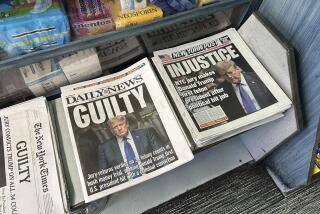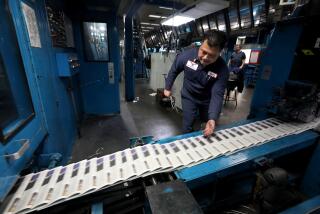Impact: HOW THE PRESS AFFECTS FEDERAL POLICYMAKING by Martin Linsky (Norton: $19.95; 260 pp.)
- Share via
We now suspect that in journalism, as in the natural sciences, simply observing an event, changes it. Accordingly, it is presumed, notably in an era in which perception and imagery are stylized as reality, that a ubiquitous press exerts a persuasive influence on public policy. Less certain, however, is in what way and to what extent this phenomenon is brought to bear upon policy makers and political institutions.
Essentially, that is what Martin Linsky and several associates at Harvard’s Institute of Politics at the John F. Kennedy School of Government set out to explore. Based on a mail survey of 500 former government executives and personal interviews with 20 federal policy makers and 16 prominent Washington journalists, the three-year study represents the most definitive research yet into the mercurial relationship between press and government and how it affects the erratic and undefined formulation of federal policy.
For the most part, books on the press have focused on it as an institution, particularly on its working patterns, practitioners and professional customs. The Harvard group embarked on the vastly more arduous task of qualitatively assessing the media’s influence in the policy arena. What it ascertained was that the press is part of the process and central to policy-making strategy far more than had been previously suggested. More than 96% of the policy-makers surveyed conceded that the press had an impact on federal policy, and a majority considered the impact substantial.
Wrote Linsky: “Because the press is such a presence, policy makers spend a lot of time thinking about and dealing with press matters. They use the press to explain themselves to colleagues and constituencies, and to learn what other officials and groups are thinking about them and their programs. They understand that what the press covers and how it covers the news can affect their policies, the way they do their jobs, and their careers. . . .”
In pursuit of their mission, the group clinically diagnosed six case studies to demonstrate the media’s effect on policy making under various circumstances--the 1969 reorganization of the Post Office Department, Vice President Spiro Agnew’s resignation, President Carter’s decision to defer production of the neutron bomb, the relocation of Love Canal residents, the Reagan Administration’s support of the tax exempt status of Bob Jones University, and the 1984 suspension of Social Security disability reviews.
(The case studies, which offer interesting detailed accounts of how policy was arrived at in each instance, are included in a separate book but without analysis or historical perspective: “How the Press Affects Federal Policymaking--Six Case Studies,” Norton: $25; 373 pp.)
The neutron bomb incident comes in for special attention. On June 6, 1977, the Washington Post carried a front page story by reporter Walter Pincus in which an unnamed source described the weapon as one which “kills people but leaves buildings standing.” Picked up by the rest of the media, the characterization provoked international outrage and created a NATO crisis which ultimately led to a decision by Carter not to deploy the bomb. Linsky comments, “It may not be possible to prove that the Pincus story killed the neutron bomb, but without his story, there might have been no issue at all.”
The study’s findings show that the press plays a large part in setting the federal policy agenda, influences how an issue is understood, and speeds up the decision-making process. Moreover, a positive press increases the chances of attaining policy objectives, while a negative press pushes the decision-making process up the bureaucracy to a higher level of government and often causes a policy reassessment.
For example, in the case of the Social Security disability reviews, the media featured a long line of recipients who purportedly were being unfairly “purged” from the beneficiary rolls because of budgetary cuts. To no avail, Reagan officials insisted that the accelerated reviews had been mandated by Congress and that reforms were being introduced to mitigate individual hardships. Eventually, the Administration, under intense press criticism, suspended the reviews.
Inevitably, any study of the media’s influence on public policy, by its very nature, tends to inflate that aspect of governmental affairs to the neglect of other independent elements, including congressional action, judicial decisions, lobbying and grass-roots pressure.
“Impact,” to its credit, recognizes that while the press can and does influence policy, it mostly creates an environment for change and is rarely, if ever, a decisive factor by itself. “Not that what we are talking about here is not the press changing policy, as if it were the major actor and determinative force,” Linsky states. “We are talking about the press having an influence on the capacity of policymakers to turn their ideas into policies that are adopted and implemented. We are talking about the press changing the odds.”
In any high-risk study such as this, there are bound to be shortcomings. There is no indication whether the influence of the press is always constructive or is sometimes pernicious and what bad journalism does to the policy-making process. In illustration, the characterization of the neutron bomb was incorrect, yet it never caught up with the story. The crucial question is, would U.S. national security and that of its NATO allies been enhanced if a sensationalist press hadn’t created a global mindset about “killer bombs”?
In its coverage of the Bob Jones University tax-exempt story, the press portrayed the Administration’s support as an example of racism and anti-civil rights when, in fact, it turned on a legal technicality over whether the Internal Revenue Service had the power to deny exemptions.
Frequently underscored is the notion that the outcome of policy decisions would have been different if the press had not been there. Yes, but the results might well have been different in a more positive way if the press had been more responsible.
On another point, the study speaks of the press as though it is a monolithic body acting in concert, when in reality it is a fragmented institution with a hundred different voices and invariably split on almost every public issue. Nor is there any reference to attempts by the government to control the free flow of information through such devices as lie-detector tests, dismissal and even criminal prosecution of government employees who leak information, lifetime censorship constrictions on federal personnel with access to classified information, and more recently, the launching of a massive disinformation campaign, including the leaking of false information to the press, to unseat Libyan leader Muammar Kadafi.
All this, of course, may be quibbling considering the refreshing light that the study sheds on an arcane subject.
“What this country needs for better government are more policy makers who are skilled at managing the media,” Linsky maintains.
He is probably right, but before we get carried away with the magic of mass communications and its omnipresent role in society and politics, we would do well to pause and muse on what T. S. Eliot had to say about the matter: “Where is the wisdom we have lost in knowledge; where is the knowledge we have lost in information.”
More to Read
Sign up for Essential California
The most important California stories and recommendations in your inbox every morning.
You may occasionally receive promotional content from the Los Angeles Times.










